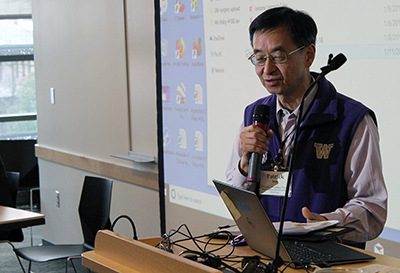Presentation Summary

Overview of Legal Foundation for Accessible IT
Presenter: Sheryl Burgstahler, University of Washington, with input from attendees
Educational institutions across the nation are under scrutiny for failing to offer accessible classes and online resources. Many civil rights complaints have been made because IT is not accessible to individuals with disabilities—including uncaptioned videos, unreadable PDFs, and inaccessible websites and information kiosks. The legal basis for these civil rights complaints is Section 504 of the Rehabilitation Act of 1973, the Americans with Disabilities Act (ADA) of 1990 and it’s 2008 amendments, and other state and local laws. Policy #188 can help us comply with these laws and collaborate in our efforts to ensure that the IT we develop, procure, and use is accessible to all faculty, students, staff, and visitors.
According to the U.S. Department of Justice and the Office of Civil Rights of the U.S. Department of Education, “accessible” means “a person with a disability is afforded the opportunity to acquire the same information, engage in the same interactions, and enjoy the same services as a person without a disability in an equally effective and equally integrated manner.” On our campuses, everyone’s ability to see, hear, learn, walk, etc. falls somewhere on a continuum. Regardless of where that is, we want to ensure that they have access to the IT we procure, develop and use.
There are two approaches for making our campuses accessible: accommodations and universal design. Accommodations are reactive and allow us to fix a product or environment to be accessible to an individual who finds it inaccessible (e.g., captioning a video when a student with a hearing impairment requests it). Universal design is the proactive approach to create all aspects of a product or environment as accessible as possible prior to completion. A building that is technically accessible would have a separate ramp for people with wheelchairs, while a building that is universally designed would have one entrance that is accessible for all.
To make IT accessible, software and websites should be designed with disabilities and assistive technology in mind. Some assistive technology emulates a keyboard but not a mouse, tabs from link to link, reads from heading to heading, and cannot read aloud content embedded in images content. This means all information technology needs to be created with keyboard-only functionality, alternative text, descriptive links, structured hierarchical headings, video captions, and transcribed audio. Considering the functionality of assistive technology can lead to better, more accessibly designed IT.
From resolutions schools have agreed to as a result of complaints of inaccessible IT, we have learned the importance of gaining support from key leaders, building on existing roles and processes, developing partnerships with vendors, applying top down and bottom up approaches, sharing consistent messages on accessibility, securing a leadership commitment, leveraging third parties for consultation and audits, adopting a reporting process, engaging with community members with disabilities, and ensuring wide publication of accessibility issues and solutions.
The University of Washington (UW) utilizes these resolutions, the latest EDUCAUSE IT Accessibility Risk Statements and Evidence report, and Policy #188 to guide its steps towards improved IT accessibility. UW promotes accessibility within an inclusive campus culture. Tasks IT departments can take on include the following:
- Undertake efforts that are both reactive and proactive and top-down and bottom-up
- Create an annual reports regarding IT accessibility
- Model IT accessibility compliance after IT security compliance efforts
- Build on current policy and procedures
- Promote accessibility within context of UD and civil rights
- Increase training, consultations, captioning parties, capacity building institutes, and other activities
- Proactively test existing websites, PDFs, and documents
- Offer incentives to encourage continued accessibility compliance
- Work in a committee to find and fix accessibility issues
Learn more about what the UW is doing, see other institution’s civil rights complaint resolutions, and find more resources at the UW Accessibility Website.